Root Cause Analysis Resources
Root Cause Analysis Training
Reliability Growth through Robust Design and Test
This three-day course provides a complete overview of the reliability growth process associated with robust design and test techniques. It defines the basic concepts of reliability growth and illustrates how these concepts can be most effectively applied using a variety of design and test methods. Topics covered include reliability growth management, reliability growth through design (FMEA/FMECA, FTA, Reliability Physics/Physics of Failure, Accelerated Life Testing, and Orthogonal Defect Classification for Software) and reliability growth through test (FRACAS; reliability planning, tracking and projection models). The course also provides unique and innovative approaches that measure, quantify and improve the effectiveness of Design for Reliability (DFR) activities.
Learn more about the Reliability Growth through Robust Design and Test course.
If you are interested in this topic, view the Achieving System Reliability Growth through Robust Design and Test publication.
Reliability Testing
This one-day course covers reliability test and evaluation approaches. The course is ideal for persons with newly assigned responsibilities in the reliability and maintainability area, as well as managers who want to increase their awareness of the proper application of various reliability test approaches.
Learn more about the Reliability Testing course.
Software Failure Modes Effects Analysis
The course covers the steps for performing a software FMEA (failure modes effects analysis) as well as dozens of software reliability failure modes and root causes related to the requirements, interface design, detailed design and code, vulnerabilities, corrective actions, serviceability, usability and processes. The course is ideal for any engineer who has been tasked with performing a system wide FMEA.
Learn more about the Software Failure Modes Effects Analysis course.
Root Cause Analysis Publications
Effective Application of Software Failure Modes Effects Analysis – 2nd Edition
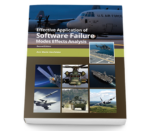 This book is a practical step-by-step guide for reliability or software engineering practitioners. It illustrates each of the steps for performing a FMEA (software failure modes effects analysis) and presents dozens of software failure modes and root causes. This book covers the eight possible viewpoints for conducting a SFMEA – requirements, interface design, detailed design and code, vulnerabilities, corrective actions, serviceability, usability and development processes. Faulty functionality, data, timing, sequencing and error handling are just some of the failure modes that are covered in this book. Real life examples of SFMEAs are shown during each step of the analysis as well as a cost benefit analysis.
This book is a practical step-by-step guide for reliability or software engineering practitioners. It illustrates each of the steps for performing a FMEA (software failure modes effects analysis) and presents dozens of software failure modes and root causes. This book covers the eight possible viewpoints for conducting a SFMEA – requirements, interface design, detailed design and code, vulnerabilities, corrective actions, serviceability, usability and development processes. Faulty functionality, data, timing, sequencing and error handling are just some of the failure modes that are covered in this book. Real life examples of SFMEAs are shown during each step of the analysis as well as a cost benefit analysis.
View the Effective Application of Software Failure Modes Effects Analysis publication.
Reliability Growth
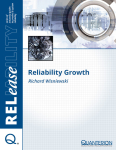 “Reliability growth is the improvement in a product’s reliability that results from the elimination or mitigation of the root causes of an item’s identified failure modes.” Stated another way: “Reliability growth is the improvement in a reliability parameter over a period of time due to changes in the product design or in operation, maintenance and manufacturing practices caused by the successful identification and correction of deficiencies in an item’s design or manufacture.”
“Reliability growth is the improvement in a product’s reliability that results from the elimination or mitigation of the root causes of an item’s identified failure modes.” Stated another way: “Reliability growth is the improvement in a reliability parameter over a period of time due to changes in the product design or in operation, maintenance and manufacturing practices caused by the successful identification and correction of deficiencies in an item’s design or manufacture.”
View the Reliability Growth publication.
Physics-of-Failure Modeling
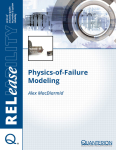 One can determine the probability of an individual failure mode’s occurrence (i.e., modal failure rates) using statistical methods, but these estimates still do not consider the underlying root cause of the failure. This publication introduces new physics-based techniques developed by reliability practitioners to address these concerns.
One can determine the probability of an individual failure mode’s occurrence (i.e., modal failure rates) using statistical methods, but these estimates still do not consider the underlying root cause of the failure. This publication introduces new physics-based techniques developed by reliability practitioners to address these concerns.
View the Physics-of-Failure publication.
Failure Reporting, Analysis and Corrective Action System (FRACAS)
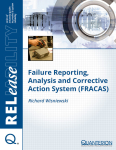 A Failure Reporting, Analysis and Corrective Action System (FRACAS) is one of the most critical elements in the development, implementation, operation and maintenance process through which the reliability of a system, including hardware and software, can be continually improved.
A Failure Reporting, Analysis and Corrective Action System (FRACAS) is one of the most critical elements in the development, implementation, operation and maintenance process through which the reliability of a system, including hardware and software, can be continually improved.
View the FRACAS publication.
Achieving System Reliability Growth through Robust Design and Test
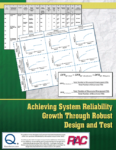 This book offers new definitions of how failures can be characterized, and how those new definitions can be used to develop metrics that will quantify how effective a Design for Reliability process is in (1) identifying failure modes and (2) mitigating their root failure causes. Reliability growth can only occur in the presence of both elements. View the Achieving System Reliability through Robust Design and Test publication.
This book offers new definitions of how failures can be characterized, and how those new definitions can be used to develop metrics that will quantify how effective a Design for Reliability process is in (1) identifying failure modes and (2) mitigating their root failure causes. Reliability growth can only occur in the presence of both elements. View the Achieving System Reliability through Robust Design and Test publication.
The hard copy is now offered with Mechanical Analysis and Other Specialized Techniques for Enhancing Reliability (MASTER), and Techniques to Evaluate Long-Term Aging of Systems (LAST) for just $238! Get this 15% reliability bundle discount.
If you are interested in this subject area, view the Reliability Growth through Robust Design and Test training course.
The Influence of Reliability, Maintainability, Quality, Supportability and Interoperability on System Affordability
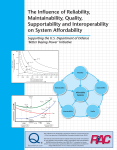 This publication discusses how the effective application of Reliability, Maintainability, Quality, Supportability and Interoperability (RMQSI) tools and processes will ensure that essential warfighting capabilities are delivered that meet system suitability requirements at the most affordable cost. The publication describes how each of the RMQSI disciplines impacts the overall affordability of a system during the evolving phases of its life cycle.
This publication discusses how the effective application of Reliability, Maintainability, Quality, Supportability and Interoperability (RMQSI) tools and processes will ensure that essential warfighting capabilities are delivered that meet system suitability requirements at the most affordable cost. The publication describes how each of the RMQSI disciplines impacts the overall affordability of a system during the evolving phases of its life cycle.
Learn more about The Influence of Reliability, Maintainability, Quality, Supportability and Interoperability on System Affordability.
Optimized Reliability Requirements and Cost Analysis (OR2CA)
 The Optimized Reliability Requirements and Cost Analysis (OR2CA) tool presents a methodology that develops contractual reliability requirements that are fully aligned with stated End-User Operational Reliability needs and expectations based on all of the categories of root failure cause that contribute to potential mission loss or degradation.
The Optimized Reliability Requirements and Cost Analysis (OR2CA) tool presents a methodology that develops contractual reliability requirements that are fully aligned with stated End-User Operational Reliability needs and expectations based on all of the categories of root failure cause that contribute to potential mission loss or degradation.
Explore the OR2CA tool.
Total Life Cycle Cost Benefits Calculator for Root Cause Failure Analysis Decision-Making
 The purpose of this workbook is to estimate the net total life cycle cost impact of performing root cause failure analysis and corrective action identification, implementation and verification to improve system, product, assembly, component, part or process reliability.
The purpose of this workbook is to estimate the net total life cycle cost impact of performing root cause failure analysis and corrective action identification, implementation and verification to improve system, product, assembly, component, part or process reliability.
It is intended to assist in determining the upfront financial investment needed to perform root cause failure analysis and corrective action for specific failure incidents and compare them to the long-term savings from the improved reliability of the system, product, assembly, component, part or process.
Learn more about the total life cycle cost benefits calculator.
To learn more about root cause analysis, visit Quanterion’s associated reliability engineering term page.
Stay informed! Sign up for reliability engineering news.
Follow Quanterion Solutions Incorporated on social media to access more reliability engineering information, resources, and more.


